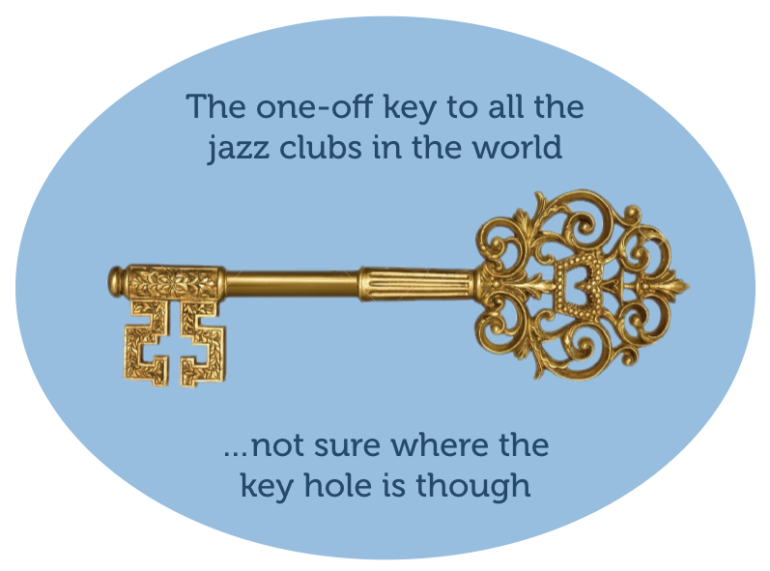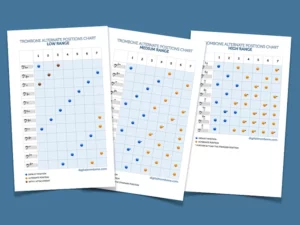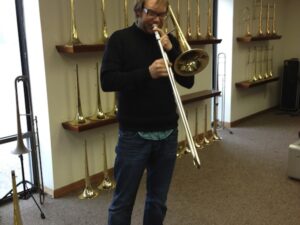
Trombone lesson: The key to improvising
I once had an advanced jazz trombone student. At our very first lesson, he played a jazz standard with me on the piano. Don’t remember what song it was, something medium up with some interesting harmony I think. His solo playing was advanced, both melodically and technically, and my first thought was “what the heck am I going to be able to learn this cat?”. But his trombone playing, as impressive as it was, didn’t touch my heart, so I had him play a slow blues, and he completely fell through. (I didn’t hang him out or tell him this, and I don’t think he realized it himself.) Lesson learned here? Theory and technique alone do not cut it.
Hear the music before you play it
You can learn all the greatest jazz licks in the world, all the fancy notes in every fancy chord, and play faster and louder than a supersonic stealth bomber and still sound like crap when you improvise. The most important factor as a jazz improviser is the ability to hear what you want to play – before you play it!
Have you ever heard the computer program Band In A Box play an improvised solo over a chord progression you typed in? The program sort of does everything right, both rhythmically and melodically, but it still sounds terrible. That is because the computer is not listening in advance! I think…
What about a B.B. King solo? No fancy rhythm and just blues scale up and down most of the time… But it sounds amazing! Because he can hear what he plays and plays with his heart.
Do you get my point? Computer versus man. Theory versus hands-on. Thinking versus feeling & hearing.
Does that mean that you don’t have to learn music theory, get great chops and be able to play as fast as the lightning (well, you don’t need to play fast to play good music…)? No, you should work on your scales, arpeggios, chord progressions, and music theory but if you don’t make sure that your ears can keep up with what you play your solos will not sound good.
Do this!
- Pick a scale that you are familiar with, for example F major. Now play the note F so that you have a reference point.
- Sing a simple melody of 2-4 tones from the scale while moving the trombone slide accordingly. No playing, just singing and moving the slide!
- Play the same melody on the trombone with the same slide positions you used when you sang it. Did it match?
- Repeat the exercise and slowly push yourself to sing longer and more melodically challenging lines.
- Start incorporating notes that are not in the F major scale (or whatever scale you picked). How does the b13 sound in relation to the major scale? The #11?
Did it match? Make sure that you keep it simple enough so that you can sing in tune with the correct slide positions, and increase the difficulty gradually. I have done this a lot, and now my slide hand starts moving as soon as I sing a melody, with or without the trombone. I have even experienced that using the wrong slide position made me sing the wrong note!
In the sheet music below there are some samples of how to approach this. You can try those phrases if you like, but the real exercise is to make your own melodies, starting super simple before pushing yourself.
Start your free trial and get access to hundreds of pages of jazz patterns and jazz etudes – all written especially for trombone.
Ready to step it up a little?
- Try using a pentatonic scale or blues scale instead of a major scale. (example 6-7)
- Try singing simple phrases over an II-V-I progression (example 7-8)
- Add some color to the dominant in the II-V-I progressions such as a b9 (example 9)
- Go for the deep end of the pool – try using an 8-tone scale or altered scale, or just go nuts and go chromatic
Is this really the key to improving?
Yes! I truly believe that. But that doesn’t mean that parallel to this, you should work on more melodically advanced stuff on your instrument – things you know you cannot sing (yet). This way, you work from two opposite directions, making you a more complete jazz improviser.
[nggallery id=13]
Did you like this exercise? Feel free to leave a comment or share it with your friends. And don’t forget to claim your free jazz etude – sign up for the newsletter now!
Have a musical day,
Anders Larson, founder fo DigitalTrombone
3 Comments
-
Hallå!
fan va bra att du lägger ut dina tankar och ideèr här. Jag ska definitivt läsa och begrunda.
Skivan som du gjorde med MNBB blev alldeled lysande. Kul!!
Du är en stor inspirationskälla för mig och mitt spel.Lycka till med allt du tar dig för.
Med bästa hälsningar,
Christoffer -
Thanks for the very kind words (in swedish) Christoffer! I might even translate them to show the world how kind you are! 🙂
-
Nice website and tips! Thanks 😉





